
* After the Vietnam War the B-52 remained in first-line service, being updated to stay effective, and became an important weapon in America's wars in the post Cold War era. It remains in service in the 21st century, over 50 years after its first flight.
* By the late 1960s, many of the older B-52 variants were nearing the end of their careers. The B-52B had been the first to go, with nearly all of them phased out by 1966, to be followed by the B-52C and B-52E in 1971. None of these variants had ever fired a shot in anger. The B-52Fs were also fading out in that time frame, but lingered on until 1978.
The B-52D, B-52G, and B-52H remained in service. In the post-Vietnam timeframe, their normal colors were Vietnam-style camouflage on top but white, not black, on the bottom. This color scheme had been basically adopted even before the B-52D had gone to war in Southeast Asia, though black had replaced white in view of the requirements there.
Programs were conducted to keep the Buffs up-to-date. Including the upgrade programs conducted in the 1960s, much more money has been spent on upgrades than was required to build the Buffs in the first place.
Several structural reinforcement programs were conducted in the early 1970s, while other upgrades gave the Buff new capabilities. In 1969:1971, a number of B-52Ds were modified to carry naval mines, giving the bomber a new role in maritime power projection. The aircraft's long range allowed it to drop these weapons at almost any oceanic chokepoint in the world. Some US Navy brass were a bit irritated with the Air Force for encroaching on their turf, and in the 1980s the Navy successfully lobbied for restrictions in US war plans on the B-52's maritime activities.
The B-52 would also be qualified for other new conventional munitions, such as cluster bombs, and all B-52Gs and B-52Hs were finally fitted to carry bombs on their external pylons. However, in 1973 SAC, never having liked sparing their precious heavy bombers for the tactical role, returned all their B-52s to operating in the strategic role, with the conventional capability left strictly as a backup.
Beginning in 1971, a total of 270 B-52Gs and B-52Hs were modified under to carry the Boeing "AGM-69A Short Range Attack Missile (SRAM)", a solid fuel, nuclear tipped weapon with a maximum range of about 160 kilometers (100 miles). Eight were stored in a rotary launcher in the bomb bay and twelve mounted on the underwing pylons in triplets. SRAM gradually replaced the Hound Dog, which was finally phased out completely in 1978. SRAM would remain in service until 1990, when it would be phased out in turn due to concerns about warhead reliability.
* One of the most visible updates to the B-52 was the "AN/ASQ-151 Electro-Optical Viewing System (EVS)", referred to as "Evs", which provided the Buff with sensors for low-level flight operations. The concept had been dreamt up by Boeing's chief of flight test, Jack Funk, in the mid-1960s. He had a Sony TV camera attached to the tailfin of a B-52, and this highly improvised fit proved very promising. Boeing's liaison to the USAF, Colonel Rick Hudlow, was told about the experiment, and he kicked the idea upstairs to SAC. The result was award of a study contract in 1965, leading to a production contract in 1970. A total of about 270 B-52Gs and B-52Hs was updated with the EVS fit between 1971 and 1976, at a total cost of $281 million USD.
The EVS cluttered the Buff with two cheek blisters, with a Hughes "AN/AAQ-6 forward looking infrared (FLIR)" camera in the right blister and a Westinghouse "AN/AVQ-22 low light level television (LLTV)" camera in the left blister. The FLIR provided images from the heat of objects in the field of view, while the LLTV could pick up scenes illuminated only by starlight.
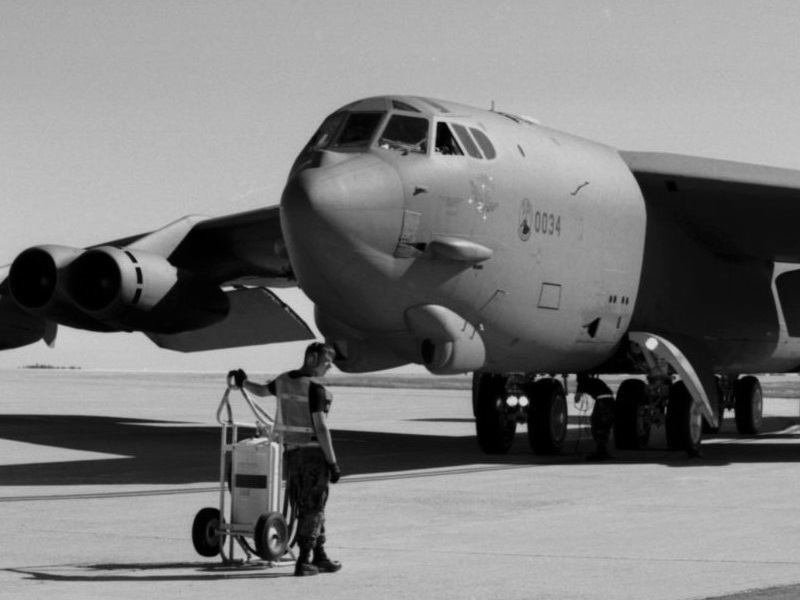
The two imagers could be steered, and in fact Buff crews call the LLTV a "steerable TV (STV)". They were to be rotated backwards in their blisters to protect them when not in use. The B-52 always was a warlike machine, and with the profusion of sensors and antennas it began to seem even more like a war dragon. The relatively sleek new-build B-52s with their splendid anti-flash white paint jobs became so much Cold War history.
The EVS included new cockpit displays not only provided imagery from the cameras but also displayed flight status information, substantially reducing cockpit workload. EVS made low-level operations much easier and safer. It also reduced the aircraft's vulnerability against adversary defenses, since the sensors allowed the bomber to be flown without use of navigation radars that could reveal the aircraft's presence, and when it was "buttoned up" with flash curtains for a nuclear strike.
* A "Phase VI ECM Defensive Avionics Systems" upgrade, codenamed "Rivet Ace", was begun more or less near the end of the EVS upgrade. It included a comprehensive update of countermeasures systems for the B-52G and B-52H, including:
The ECM enhancements led to the extension of the tail behind the tailplanes by a little more than a meter (40 inches). A "Phase VI+" ECM update would be installed beginning in 1988, with the main change being the replacement of the AN/ALQ-117 with the improved AN/ALQ-172(V)2 countermeasures system.
* The B-52D, the Air Force's workhorse in Vietnam, was finally withdrawn from service in 1983, but the B-52G and B-52H stayed on the flight lines, with the Air Force performing another level of upgrades in that decade through the two billion USD "AN/ASQ-176 Offensive Avionics System (OAS)" program.
The primary goal of the OAS upgrade was to replace the old AN/ASQ-38 BNS, since it was becoming old and decrepit, with digital, solid-state gear that was hardened to resist the "electromagnetic pulse (EMP)" associated with a nuclear blast. The upgrade included new controls, processors, and displays; a radar altimeter; attitude and heading reference system; dual inertial guidance systems; missile interface systems; and a MIL-STD 1553A data bus to link the systems together. Another minor change was replacement of the post-strike reconnaissance film camera in the belly with a videotape camera.
A B-52G was used to prototype the OAS fit, with the modified aircraft performing its first flight on 3 September 1980. Update of the B-52 fleet to OAS specification was completed in 1986, at a hefty cost of about $1.66 billion USD.
* The Quail decoy had been phased out in 1978; some sources claim that it was still regarded as effective and was eliminated due to lack of spares, but other sources claim that improved radars could easily tell the decoys from the real thing. The Air Force had hoped to field an improved "Subsonic Cruise Armed Decoy (SCAD)" with a nuclear warhead as a replacement, but it didn't happen, at least not in that form.
Arming a decoy raised the slippery question of whether it was a decoy or a missile, and what sense it made to combine the functions. Air Force brass decided that it didn't make sense and that a missile would be preferable to a decoy; the result was, after some complicated politics, the "AGM-86B Air-Launched Cruise Missile (ALCM)". ALCM was a jet-propelled, nuclear-armed missile with pop-out flight surfaces, precision low-level guidance, and a range of over 2,400 kilometers (1,500 miles). Beginning in 1982, 98 B-52Gs were equipped with the ALCM. Six could be carried on each underwing pylon, for a total of 12. Later, all B-52Hs were updated to carry the ALCM as well, with the B-52H carrying 12 on the pylons, plus an additional 8 on a "Common Strategic Rotary Launcher (CSRL)" in the bomb bay.
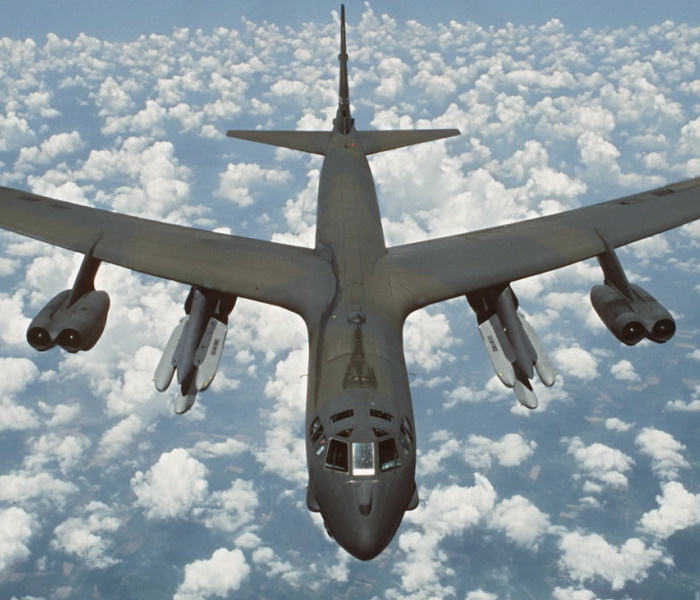
In accordance with the SALT II strategic arms-limitation treaty, "cruise missile carrier (CMC)" B-52Gs were fitted with small leading-edge wingroot extensions called "strakelets" for recognition by reconnaissance satellites. The strakelets were not fitted to B-52Hs, since all of them were CMCs and they were easily recognized by their TF33 turbofan engines -- but when B-52Hs were upgraded to the CMC configuration, they were fitted with a pair of distinctive AN/ALT-32 "elephant ear" antennas on the rear fuselage as a recognition feature. These antennas were otherwise nonfunctional.
In the late 1980s, the US also developed an "AGM-129A Advanced Cruise Missile (ACM)", an improved "stealthy" follow-on to ALCM with forward-swept wings. The ACM was also carried on B-52s, with 20 fitted to a B-52H in an arrangement similar to ALCM carriage. The ACM was produced in more limited numbers than the ALCM. Neither ALCM nor ACM as such have ever been used in combat; however, a large number of ALCMs were converted to a conventionally-armed configuration, beginning in the 1980s under conditions of great secrecy, and these "Conventional ALCMs (CALCM)" would become a weapon of choice for the B-52, as discussed later.
In the mid-1980s, in yet another effort to encroach on the Navy's sea-control mission, 30 B-52Gs were also modified to carry a total of eight "AGM-84 Harpoon" antishipping cruise missiles on the external pylons. 19 B-52Hs were later modified for the same weapons fit. The Harpoon-carrying Buffs were to cooperate with Navy patrol aircraft, such as the Lockheed P-3 Orion, which provided over-the-horizon targeting for the bombers.
* Even with the new guided weapons, the B-52 still retained its traditional armament of free-fall nuclear bombs. The nuclear munition types carried by the B-52 in the 1960s were more or less phased out in the 1980s, but the Buff could carry newer weapons, including the "B61" and "B83".
The B61 or "silver bullet" was a lightweight weapon with a selectable yield, ranging from tens to hundreds of kilotons. It was introduced in the late 1960s. It was carried on clips and on the CSRL, with a maximum bombload of 12 munitions. The B83 was a strategic weapon, with a yield in the megaton range; it was introduced in the early 1980s. Carriage options were similar to those for the B61.
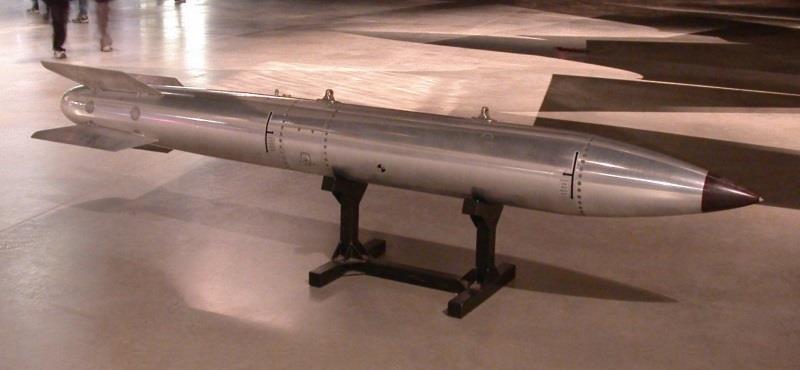
* The B-52s were also fitted with less destructive payloads for other missions. Four B-52Hs were modified to carry an air-sampling module in the forward bomb bay to detect radioactive traces from nuclear tests or accidents. The gunner's station was modified to permit control of the module, which weighed about 900 kilograms (a ton) and had five retractable sampling scoops. These aircraft were referred to as "Giant Fish" for some reason. It is unclear when the modifications were performed and apparently two of the machines were quickly restored back to normal service, but Giant Fish B-52s were used for atmospheric monitoring during the 1986 Chernobyl nuclear reactor disaster. Details of the program are unclear; it appears the Giant Fish machines were eventually restored to bomber service.
* Another major upgrade of the B-52 was begun in 1985, when all B-52Hs and a number of B-52Gs were fitted with the Norden "AN/APQ-166 Strategic Radar System", replacing the AN/AQS-176 unit, itself a replacement for the AN/ASQ-38 BNS. The "Strat Radar" upgrade involved fit of the radar and a number of auxiliary systems. It was a complicated piece of work, and cost about $700 million USD.
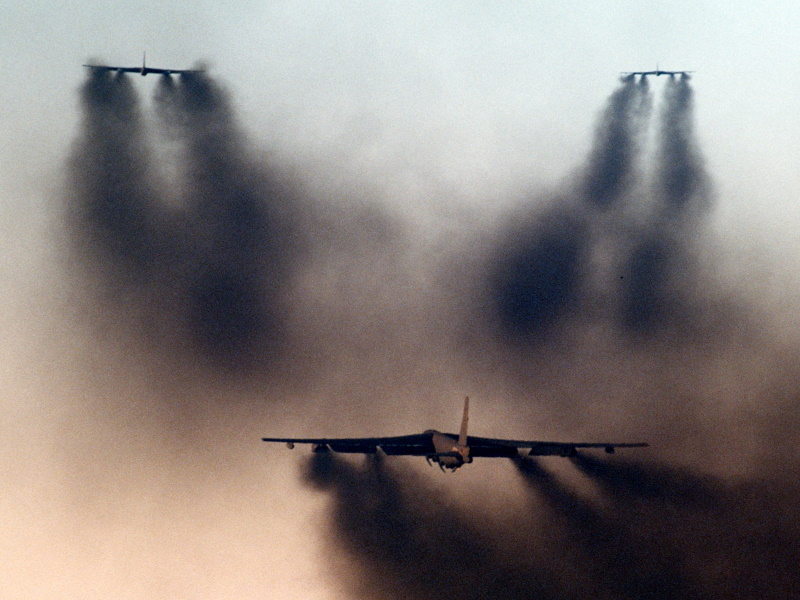
The gradual thawing of the Cold War in the late 1980s, which would lead to the collapse of the Soviet Union in the early 1990s, meant that the mission that SAC had been organized to fight was starting to go out of fashion. In May 1988, SAC officially tasked some B-52 units to the conventional bombing mission in order to keep up with changing circumstances. That was good timing, since after almost two decades of peace, the B-52 was nearing the day when it would go back to war and put all the improvements of the 1970s and 1980s to practical use.
BACK_TO_TOP* The Buff returned to combat during the Persian Gulf War in 1991 as part of the air campaign during Operation DESERT STORM, the effort to evict Iraqi dictator Saddam Hussein's forces from Kuwait. About 80 B-52Gs operated against the Iraqis from bases in the US and overseas, including Jeddah, Saudi Arabia; Moron, Spain; RAF Fairford in the UK; the remote Diego Garcia island base in the Indian Ocean; and a few other installations. They were painted a dark military gray, the new standard paintjob for the Buff, adopted after some interim experiments with gray patterned camouflage schemes.
On 17 January 1991, seven B-52Gs, appropriately known as the "Doom Flight", took off from Barksdale AFB in Louisiana to help kick off the air campaign. They performed a flight that lasted 35 hours and took them almost halfway around the world to launch 35 CALCMs and then go back home. The routes of the missiles were planned so that they would impact almost simultaneously, and 33 of the CALCMs hit their assigned targets. That same day, B-52Gs followed up this strike with the first low-level attacks conducted by the type after decades of training. Buffs swept into Iraqi airspace at an altitude of 90 meters (300 feet) to pound four airbases and a highway.
With Iraqi air defenses disabled, the B-52Gs then returned to high-altitude bombing, with three-ship formations pounding Iraqi troops concentrations in Kuwait with 340-kilogram (750-pound) bombs and cluster bombs. The B-52 performed 1,600 sorties in the Gulf War and dropped 22,725 tonnes (25,000 tons) of munitions. Heavy bombing attacks were usually performed every other day; on the "quiet" days, Iraqi troops were hit with leaflet drops, telling them which of their divisions had been hit the day before, which division would be hit the next day, and encouraging them to desert and surrender.
No B-52s were lost in action, but one Buff crashed in the Indian Ocean on the way back to Diego Garcia after an electrical system failure, with the loss of three crew members. The crew was in sight of the island when their ship went down. Two other B-52Gs were hit by Iraqi SAMs, and one was unlucky enough to be hit by a US "high-speed anti-radiation missile (HARM)". The HARM was fired at an Iraqi radar that then went silent, and the missile then locked onto the tail radar of a B-52G and hit the bomber. All three of these aircraft made it safely back to base.
* Following the Gulf War, in the fall of 1991, US President George H.W. Bush ordered that the alert system be abandoned, and for the first time since 1957, nuclear-armed Buffs were no longer sitting on the tarmac, waiting for the word to get into the air and conduct nuclear strikes.
SAC itself was disbanded in an Air Force reorganization in June 1992. Although the B-52 remained a strategic weapon, with crews continuing to train for the nuclear mission, with SAC gone the B-52 was now essentially just another weapon that could be assigned to whatever necessary role, instead of being jealously guarded as a strategic asset and only reluctantly released for other roles.
Another change was the gradual elimination of defensive armament. The tail turrets of all surviving B-52s were removed in 1991:1994, since the guns were no longer considered to be a particularly effective defense and were a maintenance headache. Crews described the disarmed Buffs as "Bobbited", in reference to a contemporary marital dispute involving an angry wife with a knife that got national headlines. The guns were replaced by a panel, which was perforated to ensure equalization of pressure -- sometimes being referred to as the "cheesegrater".
The B-52 force was continuing its slow decline during that time. Phaseout of the B-52G began in 1989, with the variant getting a temporary lease on life due to its sterling service in the Gulf War, but the last B-52G was withdrawn from service in 1994.
The major reason for obsoleting the B-52G was the old water-injected J57 engines. Maintenance was a problem, but there was also the fact that water injection was an idea whose time had long passed. As one B-52 pilot put it:
BEGIN_QUOTE:
The idea of dumping tons of water into a fire is as absurd as it sounds. If the pumps don't work or you lose the water augmentation, conditions can become critical. What can also happen is that you can put out the fire in the engine. If you put out two engines in the outboards, you not only lose the engines, but you give yourself a nightmare of a directional control problem. It's a problem that is serious. It gets your attention.
END_QUOTE
* Calling water injection "absurd" was a bit of an exaggeration, since it was successfully used in many different kinds of aircraft for decades and the J57 was a landmark of jet-engine design. However, water injection had become stone-axe technology, and nobody was unhappy to see it go. Unfortunately, killing off the B-52G because of its antique engines emphasized the uncomfortable fact that the TF33 turbofans used on the B-52H were almost as old and archaic as the J57. Although much better than the J57, the TF33 wasn't comparable to the modern high-bypass-ratio turbofans used on modern jetliners.
In 1996, Boeing, as leader of a team including Rolls-Royce, Allison, and American Airlines, proposed an engine upgrade for the B-52H, replacing the eight TF33s with four Rolls-Royce RB.211 turbofans, and adding cockpit engine control displays developed for the Boeing 757 airliner. Boeing's analysis demonstrated that the more fuel-efficient and reliable RB.211s would save billions of dollars over the expected further lifetime of the B-52H fleet. In addition, the RB.211s would provide substantially more power and range, as well as quieter and cleaner operation.
The industry team's proposal included full-service maintenance and flexible financing, essentially allowing the Air Force to pay off the new engines as part of normal operating costs after installation. The pitch was that this would still be cheaper than continuing to operate the TF33s. Air Force brass were tempted, but didn't buy off on the concept. The service was focused on other procurement priorities, such as a new tanker fleet, and did not want to expend resources on old news such as the B-52. The idea kept popping up every now and then in the following years, but went nowhere in any hurry.
* The B-52H was given other upgrades, however. Beginning in the early 1990s, a number of B-52Hs were fitted to carry the "AGM-142 Have Nap" standoff weapon, an Americanized variant of the Israeli Rafael "Popeye" missile produced in cooperation with Lockheed Martin. The AGM-142 was a solid-fuel missile with a 900-kilogram (2,000-pound) warhead and a precision imaging guidance system for pinpoint attacks. The radar navigator guided it to a target using a joystick and watching the images from the missile's seeker on a display. Two AGM-142s, or an AGM-142 and a guidance pod, could be carried on each B-52H external pylon.
Later on in the decade, the B-52H was fitted to carry the new "Joint Direct Attack Munition (JDAM)" family of smart bombs, and the "AGM-154 Joint Stand-Off Weapon (JSOW)" guided glide bomb. These weapons use the "Global Positioning System (GPS)" satellite constellation to zero in on target coordinates; they could only be carried on the external pylons, however, the bomb bay rotary launcher not being wired to handle smart munitions.
Use of the JDAM and other GPS weapons was enabled by yet another Buff avionics upgrade, the "Conventional Enhancement Modification (CEM)" program, which was begun in 1994. New kit provided by the CEM included:
Although not part of the CEM program as such, the B-52H was fitted with another item, the "AN/AS-3858 / AN/AAR-85T(T) Miniature Receive Terminal (MRT)", in the same timeframe. The MRT is a five-channel LF/VLF receiver that allows messages to be sent to the bomber.
At some time before the CEM upgrade, the Buff was also fitted with the "AN/ARC-171(V)" UHF/AFSATCOM radio, which permits the bomber to perform communications over the US military's satellite communications system. Exactly when this fit was performed is unclear, but it gave the B-52H clear communications from almost anyplace in the world.
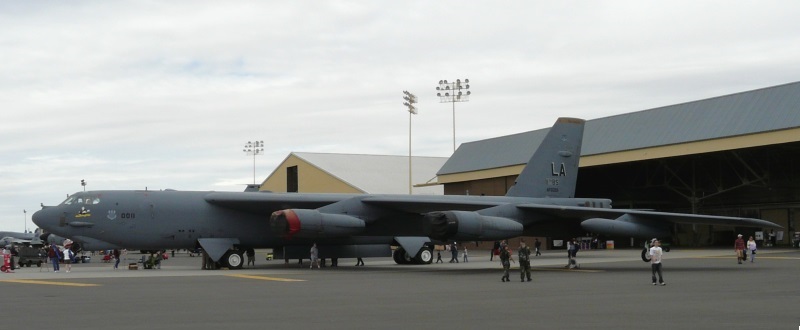
* Even as the Air Force was hesitating on an engine upgrade, the service was sending the B-52H back to war again, and in fact the Buff was busier than it had been in decades.
On 3 September 1996, the US launched a set of attacks against Iraqi air defense sites, in response to harassment of Western aircraft patrolling Iraqi airspace. B-52Hs flying out of Guam launched 13 CALCMs, in cooperation with strikes by other aircraft and US Navy Tomahawk cruise missiles. The strikes generally achieved their goals, but there were reports of CALCM failures and planning glitches that targeted some of the CALCMs on hardened facilities where their fragmentation warheads would have no effect.
Iraqi provocations continued, and on 16 December 1998, the US and Britain launched an even more comprehensive set of strikes under Operation DESERT FOX. On 17 December, the Buffs provided their contribution to the operation by launching 90 CALCMs.
The Buffs had hardly caught their breath from this action when they were committed to Operation ALLIED FORCE, the NATO operation to evict the Yugoslav Army from Kosovo, in February 1999. B-52Hs operating from Barksdale and Minot AFB in North Dakota flew 270 sorties, beginning in March with six Buffs launching CALCMs to help spearhead the attack, followed by strikes with iron bombs and cluster munitions on Yugoslav Army units.
BACK_TO_TOP* The B-52H continued to provide excellent service during the war in Afghanistan in 2001:2002. Buffs operating out of Diego Garcia performed precision strikes with new JDAM GPS-guided bombs, first taking out planned targets, and then operating in a reactive close-support role. The bombers would orbit in the operating area, receiving attack orders and coordinates in flight. The crew would program a few bombs, drop them to hit the specified targets, and then wait for further instructions.
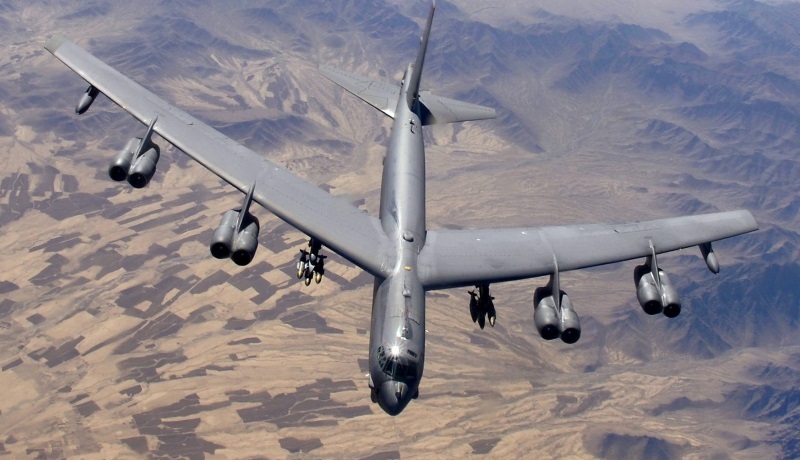
A little over a year later, in the spring of 2003, B-52s went back to war once more, providing strikes during the American invasion of Iraq. During the campaign, B-52s operated with yet another external store, the Rafael / Northrop Grumman Litening II targeting pod. The pod, which included magnifying day-night optics and a laser target designator, allowed the B-52s to conduct precision strikes on targets (with laser-guided bombs) from high altitude.
The Litening II pod was mounted on an external pylon. The Air Force Reserve managed the program, promoting it in the face of skepticism that targeting pods, traditionally a strike fighter store, were appropriate for heavy bombers. Funding finally became available in late 2002, with flight testing beginning early in 2003. A total of 12 Buffs was modified in all initially, though the USAF only acquired six pods at the outset. From that time, B-52s carried either the Litening II or comparable Lockheed Martin Sniper pod. The pods came in handy in navigation as well as precision targeting, since their imaging systems were much more advanced than those of the antiquated EVS system.
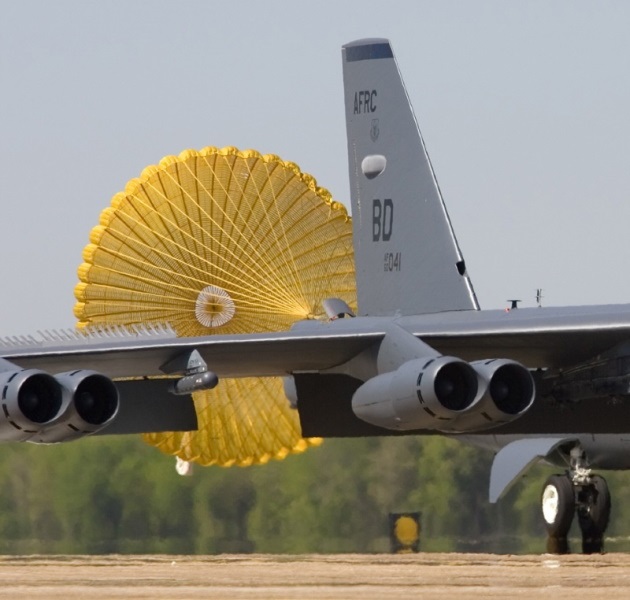
From 2016, B-52s posted to Al Udeid Air Base in Qatar conducted strikes on Islamic State insurgents in Iraq and Syria, using the Sniper pod for precision attacks. During that timeframe, they also performed long-range strategic flights out of Barksdale as warnings to Russian President Vladmir Putin, who was engaged in anti-American propaganda and subversion, as well as attempting to intimidate NATO allies in Eastern Europe.
* B-52 operational flights are now the job of the 307th Bomb Wing (BW) of the USAF Global Strike Command, the 307th consisting of four Bomb Squadrons (BS) at Barksdale. The 307th continues to bring new crews up to speed on the Buff -- a "Major Pablo" of the 11 Bomber Squadron of the 307th saying in 2017: "Most of our trainees are young lieutenants who come to us fresh from the undergraduate pilot training."
Pablo said that the trainees begin with book learning, with flight simulators helping them get a fingerhold on the non-trivial task of flying the B-52, which he called "a hard machine to fly":
BEGIN_QUOTE
The difference coming from a T-38 training jet is enormous ... You have to remember that the B-52 is not a fly-by-wire aircraft. Flying it can be tough, exhausting, and it can tire you out. It takes a while to build up the muscles to fly the B-52.
END_QUOTE
The high wing incidence and nose-down climb take some getting used to, as does the fact that the B-52 has spoilers instead of ailerons: "So you turn the yoke, wait for a few seconds, and then the machine begins to turn." One thing new to modern B-52 crews is the use of smart munitions, according to Colonel Robert Burgess, commander of the 307th:
BEGIN_QUOTE
One of the biggest changes in the weapons [syllabus] is the introduction of the Lockheed Martin Sniper Advanced Targeting Pod. Learning to use the Sniper pod is one of the biggest challenges for our students. Preparing for the weapon release is a very dynamic situation. You have got to understand what is happening on the ground. You have to look at the target, find out if it is the right target. Is it a valid target? An authorized target? Or is it a hospital, or school, or a church?
You have to do a lot more thinking than in the past. In those days you might not even see the target; you just bombed at a certain point, and went home. But now I need to see the target, have a visual on it with the pod ... If we have smart weapons that can guide themselves that helps; but ultimately we need coordinates.
END_QUOTE
Burgess had been trained on the B-52 from 1990; he commented that flying the Buff was much the same then as it is now, but the mission profiles had changed:
BEGIN_QUOTE
We used to fly a lot of low-level, flying 500 feet [150 meters] or lower, but we don't do that mission any more. It's now all mid to high altitude. We can still do it, but we don't train for it, and the weapons have become a lot more modern. Instead of carpet-bombing, like in the past, throwing a lot of bombs on one target, we are now dropping individual bombs on a bunch of different targets.
Students nowdays are very computer-smart, and pick up easily on software and the systems on the airplanes. On the other hand, you have to tell them exactly what to do, because they are usually so busy with their phones and on social media. Believe me, every generation thinks the younger generation doesn't really know what's going on, but eventually we all end up well.
END_QUOTE
* The Buff is still a long way from the end of its service life. To be sure, B-52Hs began to be retired in 2008, but that was a force reduction of 18 aircraft, cutting the fleet from 94 to 76, that number of machines being felt adequate to support the Buff's mission taskings, and also the limit set by arms limitation treaties. After one was badly damaged in 2014, a mothballed Buff was withdrawn from storage and brought back up to operational service. Another was returned to service in 2019. At that time, there were 58 B-52Hs in operational service, with 18 in reserve, and about a dozen in mothballs. The surviving B-52Hs have plenty of airframe life left in them.
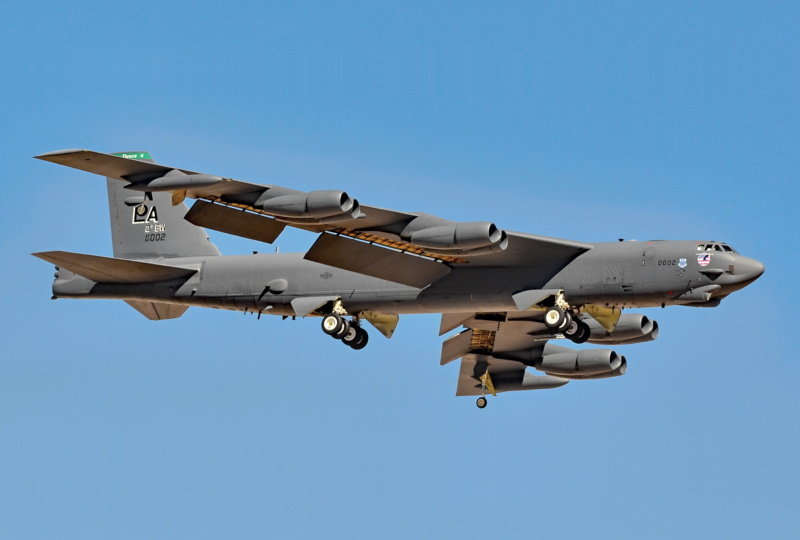
One scheme that was explored was to modify the aircraft to operate as a "stand off jammer (SOJ)" platform, with jammer pods replacing the outer-wing tanks. The effort ran into trouble initially, with an initial jammer pod spec proving unrealistically expensive. The effort was then scaled back to an investigation of options; at last notice, the program seemed to be in limbo.
From 2014, there were experiments of the B-52H carrying a AN/ASQ-236 Dragon's Eye radar pod on an underwing pylon, the Dragon's Eye being an active array radar, with a particular focus on SAR observations of sea traffic. The Dragon's Eye is regarded as enhancing the B-52H's maritime strike capability by providing a search and targeting function for Harpoon missiles.
Upgrades have continued and are ongoing, one effort being to modernize the ALQ-172(V)2 ECM system to improve reliability. Another is an "Avionics Midlife Improvement Program" to replace the inertial navigation system, digital processors, and other kit. Still another program designated "Combat Network Communications Technology (CONECT)" was initiated in 2005 to provide the B-52H with the Link 16 digital datalink, along with networking workstations and associated gear. CONECT allows the B-52H to cooperate with other intelligence and strike platforms during operations.
From 2016, the rotary bomb bay launcher was updated to "Conventional Rotary Launcher (CRL)" configuration under the "Internal Weapons Bay Upgrade (IWBU)", the original intent being to accommodate JDAM. The new launcher featured the MIL-STD 1760 interface system to link compatible munitions to the B-52's systems. The old rotary launcher also had a problem in that no more than four munitions could be powered up at one time without tripping circuit breakers, meaning that a B-52 would have to make two passes to drop eight munitions. With the CRL, all could be powered up at the same time. A second-phase update to the CRL allowed it to carry:
In 2014, the Air Force began a "Radar Modernization Program (RMP)" to replace the AN/APQ-166 radar, eventually selecting the much more modern AN/APG-79 radar -- an "active array" radar, a variant of the same radar developed for the Boeing F/A-18E/F fighter. It features greater range and is much more intelligent, as well as resistant to countermeasures.
In 2017, the Air Force began a study to replace the B-52H's wheels and brakes, following the loss of an aircraft on Guam the year before. The Buff's brake chute failed, and the brakes ended up setting the machine on fire, destroying it, the crew escaping safely. There are of course plans to qualify the B-52H for new weapons, such as the "Long-Range Stand-Off (LRSO)" missile, to replace the ALCM -- incidentally, the ACM had been retired in 2012, partly as an arms reduction measure, partly because it was not particularly reliable.
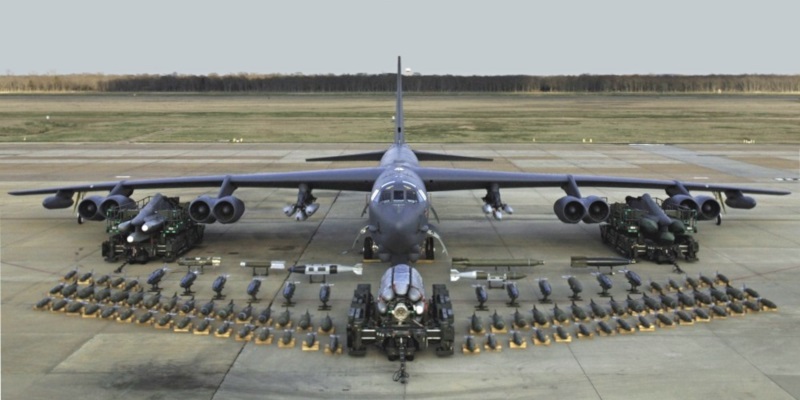
In 2018, the USAF began work on a program to replace the B-52H's original underwing stores pylons, which are only rated up to 2,270 kilograms (5,000 pounds) each, to new pylons with four times that load capacity. The heavyweight pylons are on a fast track, since they will be needed to evaluate new missiles that will eventually be added to the B-52's arsenal. -- including the Lockheed Martin "AGM-183A Air-Launched Rapid Response Weapon (ARRW)" and "Hypersonic Conventional Strike Weapon (HCSW)", AKA "Arrow" and "Hacksaw" respectively.
AGM-183 test flights on the B-52 began in 2019. Details are not entirely clear, but the missile was apparently the Defense Advanced Research Projects Agency's (DARPA) "Tactical Boost Glide (TBG)" demonstrator. It was supposedly canceled in 2023 after failed flight tests, but the program appears to be continuing, possibly after being redefined. As for HSCW, not much has been said about it yet.
The Air Force is also working on air-breathing supersonic weapons, powered by supersonic combustion ramjets (scramjets) -- technology that was evaluated with test launches from the B-52 of the NASA X-43 in the 2000s, and the follow-on USAF-Boeing X-51A from 2010 into 2013. Lockheed Martin's Skunk Works and Raytheon are working under contract with DARPA to develop the derived "Hypersonic Air-breathing Weapon Concept (HAWC)", again with not much announced just yet.
The B-52 is said, convincingly, to have had the longest first-line service career of any combat aircraft in history, and there is still life in the old Buff yet: the Air Force doesn't plan to retire it until 2040. Interest in an engine upgrade has revived -- not surprising, given the fact that the TF33 engines are not getting any younger and any easier to keep in operation. The Air Force began reconsidering the matter in late 2014; given the past history of re-engining concepts, nobody would have read too much into that, but by the spring of 2017, Air Force brass were telling Congress it simply had to be done. The TF33s were increasingly difficult to maintain, and spare parts were hard to scavenge up; the TF33 could not possibly be kept in service beyond 2030.
As a result, the "Commercial Engine Replacement Program (CERP)" was initiated in 2019. The Air Force, to reduce costs, envisioned fit of eight relatively small turbofans instead of four big ones, which would permit use of the existing nacelle design, with modifications. GE, Rolls-Royce, and Pratt & Whitney all offered solutions -- one from PW suggesting substantially upgraded TF33. Rolls-Royce won the competition in 2021 with their "F130" turbofan, a military version of the Rolls-Royce BR725, used on business jets. It has digital engine controls, 75.6 kN (7,710 kgp / 17,000 lbf) thrust, will extend the B-52's range by 40%, and will be much more serviceable.
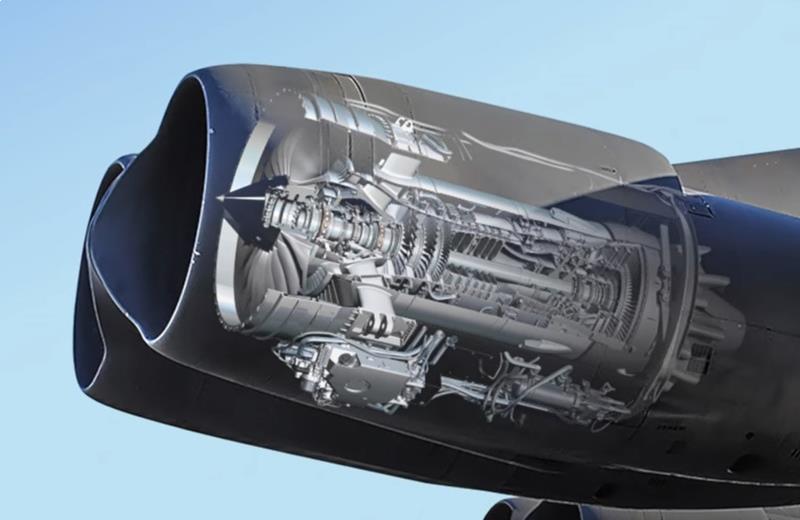
There will be several other changes, the most visible being elimination of the EVS blisters. A Litening or Sniper pod could do that job better, and the low-level mission for which EVS was designed had been de-emphasized anyway. The cockpit will be updated as well, along with updates of other aircraft systems. Schedule is not clear yet, but the last upgrade will be delivered in 2038.
There has been talk about an upgraded "B-52J", which would presumably have the updated engines and other modernizations. However, there's been nothing but casual talk on the matter so far, and earlier references to the B-52J were in the context of an "arsenal plane" -- a large aircraft crammed full of stand-off munitions that could lurk near or in a battlespace, to deliver firepower on request.
BACK_TO_TOP* If there's any aircraft I'm familiar with, it's the B-52. I grew up in Spokane, Washington, under the approach path to Fairchild AFB outside the city, and have clear memories of the big bombers coming in directly overhead every day, carrying Hound Dogs on their pylons. During the Vietnam War I would see camouflaged B-52s flying in as well. Fortunately, our house was far enough away so that the noise was no bother. I do have memories of being someplace or other around town and hearing an absolutely thunderous rumbling roar in the distance towards Fairchild, but it wasn't until a few years ago that I learned about water injection and understood what had been happening.
The Air Force would parade Hound Dogs through town on parade for the city festival, Lilac Day, in the spring. I also have the damnedest fuzzy memory of being a little fellow and inspecting a Quail decoy, that as best as I recall, was set up for display in a shopping mall. I also vaguely recall there was no one watching over the thing, which would be unthinkable now. Possibly people were more civilized when I was a youngster.
Of course, the B-52 figures prominently in another memory of the era, Stanley Kubrick's movie DOCTOR STRANGELOVE, OR HOW I LEARNED HOW TO STOP WORRYING AND LOVE THE BOMB. Kubrick's film remains a tribute of sorts to the Cold War, characterized by a chilly brand of satire and humor, ending with the classic scene of Major "King" Kong, a B-52 commander played by Slim Pickens, riding an H-bomb down out of the bomb bay like a rodeo cowboy into a blaze of glory.

* Sources include:
Illustrations credits:
* Revision history:
v1.0.0 / 01 jul 02 / Initial release, two chapters. v1.0.1 / 01 jul 03 / Review & polish. v1.0.2 / 01 may 05 / Review & polish. v1.0.3 / 01 sep 05 / Review & polish. v1.0.4 / 01 aug 07 / Review & polish. v1.0.5 / 01 jul 09 / Review & polish, went to three chapters. v1.0.6 / 01 jul 11 / Review & polish. v1.0.7 / 01 jun 13 / Review & polish. v1.0.8 / 01 may 15 / Review & polish. v1.0.9 / 01 apr 17 / Review & polish. v1.1.0 / 01 mar 19 / Review, update, & polish. v1.1.1 / 01 feb 21 / Review, update, & polish. v1.2.0 / 01 aug 22 / Illustrations update. v1.2.1 / 01 may 24 / Review, update, & polish. (++)BACK_TO_TOP
